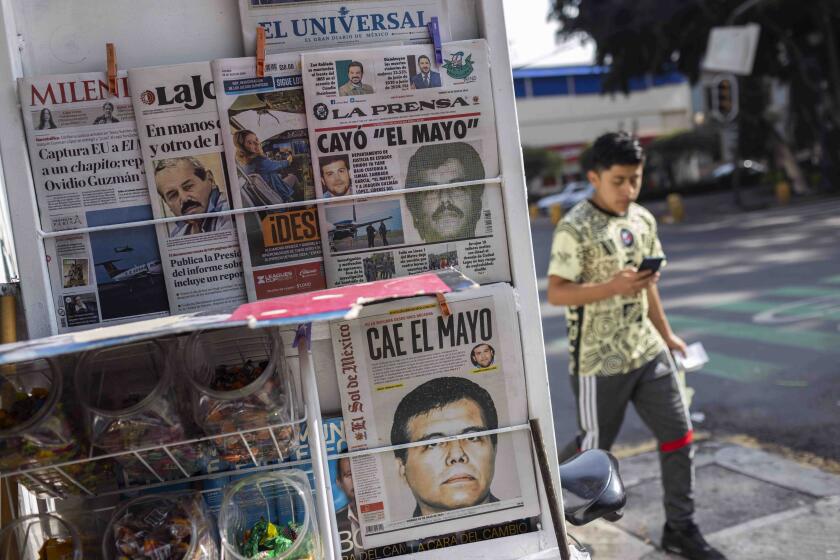USDA Plans to Beef Up Livestock ID System
The cow kept losing her ear tag. Again and again, she’d rub against a fence or a tree until the plastic tag, about the size of an index card, fell off.
So rancher David Watson had to improvise when tracking her in his well-thumbed booklet of herd production records. “Big Red,” he wrote in the space set aside for her tag number. Then he drew an awkward sketch of the crescent-shaped birthmark on her face.
In much of the country, that’s as scientific as cattle identification gets.
Millions of wild salmon have microchip IDs implanted in their bellies so biologists can track the fish individually as they navigate hydroelectric dams. Veterinarians inject similar microchips into dogs and cats and pet birds. Even some teddy bears now come with bar codes embedded in their furry ears so they can be returned to the right child if they’re left behind on a swing set.
But the beef industry has never felt much need to keep tabs on each individual animal. Until now.
Responding to last month’s discovery of a Holstein infected with mad cow disease, Agriculture Secretary Ann M. Veneman has called for a national livestock identification system. Several promising technologies are being tested around the nation, including one here on Watson’s rolling ranch in southwest Kentucky.
Some beef ranchers resent the high-tech chips and sensors as too expensive and, even, too precise; they’re not sure they want consumers to know which farm produced which steak. Many others, however, share federal officials’ hopes that a national identification program will allow them to control disease outbreaks, limit economic losses and help them run their ranches more efficiently.
Cattle today are often shuttled anonymously through three or four owners before they reach the slaughterhouse. Little, if any, paperwork identifies each animal individually.
That’s why it took federal veterinarians six days to find the infected Holstein’s birth farm in Canada. They still have not been able to locate more than a dozen dairy cows from the animal’s birth herd. And, unable to identify the infected Holstein’s offspring, they euthanized hundreds of calves to be sure they got the right ones.
Since that fiasco, “everyone’s getting more and more used to the idea of having to go to a national ID system,” said Bim Nelson, a cattle auctioneer in Bassett, Neb. He still prefers the old-fashioned way of marking a cow, by branding it on the rump with a red-hot iron. But since the mad cow scare, he’ll grudgingly consider going high-tech. “It makes sense,” he said.
The USDA plan, still sketchy, calls for tagging all 105 million U.S. cattle with the bovine equivalent of a Social Security number -- an electronic code that will stay with the animal as it moves from ranch to feedlot, from state to state, from birth to slaughter. The European Union and Canada already use that type of system.
Here in Kentucky, the state and the beef industry have each put up $4 million for a pilot ID program using radio-frequency tags, known as RFIDs. They look like buttons punched through the cow’s ear; each one emits a unique signal, which can be scanned with a hand-held wand.
In Colorado, Idaho and Texas, the meatpacking firm Swift & Co. plans to begin identifying its cattle with retinal scans, which measure the one-of-a-kind pattern of blood vessels at the back of the eye.
From Minnesota to Mississippi, inventors are promoting all manner of livestock tracking technology, from implanted microchips to sensors that can be linked by satellite to the global positioning network. The stock of firms offering such devices, such as Digital Angel and Advanced ID Corp., has soared in the last two weeks.
A USDA task force estimates that a high-tech identification program would cost $600 million to launch and $100 million a year to maintain. For ranchers, that could get expensive; electronic scanners and scales can cost thousands of dollars. For consumers, though, the cost should be negligible, just pennies per pound of beef.
The technology has astounding potential, both for disease containment and for efficiency.
Ranchers who now lose track of their cattle when they sell them six months after birth could in the future be able to get reports from the slaughterhouse two years later, telling them that No. 51898 produced the leanest roasts and No. 32400, the most lusciously marbled steaks. The ranchers could then adjust their breeding programs to emphasize the genetic lines that make them the most money.
David Watson and his father, Larry, who own 100 cattle, can already see the benefits from Kentucky’s pilot program.
“If I find out [from the slaughterhouse] that one of my cows has produced a calf that nets out $600 worth of meat, and another has produced a calf that nets $1,100, well, you know which of those cows will be culled from the herd,” Larry Watson said.
Plus, the electronic tags are a lot more reliable for tracking a lone cow through the expanse of his ranch than the sketches his son scribbles in the record book -- or the descriptions they jot down by the ear tag numbers (No. 109 -- black, black face; No. 036 -- big black baldy; No. 649 -- big baldy, lots of white, older).
Still, for all the promise of the new tracking plan, Larry Watson has reservations.
There’s a certain comfort in the anonymity of the current system. Many ranchers worry that farm-to-plate tracking will leave them vulnerable to consumer lawsuits.
Every year, thousands of Americans are sickened by meat contaminated with E. coli, salmonella, listeria and other pathogens. Most of the contamination occurs in packing plants, restaurants or home kitchens. But with the new tracking system, a diner might be able to find out exactly where the cow that provided his nauseating burger came from.
“Everyone passes the buck, and we’re the very last person in the chain,” said John Lockie, executive director of a group called R-CALF, which represents 9,000 cattle ranchers.
His members also worry about preserving their privacy; they don’t want their neighbors, much less their competitors, snooping through an industry-wide database to find out how many cattle they own or breed or sell. “It’s personal, just like the amount of money in your bank account is personal,” Lockie said.
There are also practical difficulties in creating a unified system for an industry that produces 26 billion pounds of beef a year.
“It’ll be like turning around the Queen Mary,” said Barry Bennett, the president of Advanced ID, which is testing its RFID tags in Canada, Argentina and Australia.
“It’s a monumental task, I will say that,” agreed Scott Stuart, president of the National Livestock Producers Assn.
Stuart sits on an animal-identification task force set up by the USDA in January 2003. The group’s proposal, which the USDA is using as a draft, calls for states to develop “premise databases” listing every farm, feedlot and slaughterhouse by this summer. Then producers would be asked to start using electronic ID tags, at first on a voluntary basis.
The ultimate goal: to be able to track every cow in the nation by July 2006.
Critics, including some ranchers, say that’s not fast enough -- that consumers and especially foreign markets will lose faith in American beef if the industry can’t track its product from barn to table by the end of this year.
Stuart defends the timetable as “pretty aggressive,” given the size and diversity of the beef industry.
There are 805,000 cattle ranchers and 95,000 feedlots in the nation, scattered across all 50 states.
A big-time Texas rancher with a sophisticated breeding program might maintain an intricate database on each of his thousands of purebred Angus, to help him pick out those with the best genes. A tobacco farmer in Virginia who runs a dozen Charolais on spare land might not bother with records of individual cows, finding it simpler to round up a few calves at random now and then to sell.
As soon as the animals are weighed at auction, they’re driven into pens crammed with hundreds more yearlings. Then they’re sold in batches to feedlots across the nation.
“When we get a truckload of 120 calves, they may have come from 80 or 90 herds. We don’t know where they’ve come from,” said Tom Moxley, who runs a feedlot with up to 5,000 cattle in Council Grove, Kan.
In tracking the Holstein infected with mad cow disease, federal veterinarians quickly learned that such a patchwork system can make tracing an animal impossible.
Picking through boxes of documents and ledgers in several states, they sorted through a tangled web of sketchy and sometimes contradictory information, gleaned from rancher notes, auction-house weighing slips, bills of sale, health certificates and ear tags.
It took them six days to find the infected Holstein’s birth farm. Nearly three weeks later, they have located only 19 of the 81 dairy cows that crossed the border from Canada with the cow in 2001. Even more important, federal officials are still trying to figure out whether other heifers from the sick Holstein’s birth herd were shipped to the U.S. at a later date. That’s critical because the herd might have eaten the same feed that could have contaminated the Holstein with mad cow disease, formally called bovine spongiform encephalopathy. Humans can contract a variation of the brain-wasting disease by eating infected meat.
Federal officials traced the Holstein’s youngest offspring to a herd in Washington state. Because they could not pick the cow out of the herd, they euthanized all 449 calves last week.) The veterinarians plan to kill 129 cows at a second farm because they believe some of the animals may have been from the Holstein’s birth herd.
To many, the waste of so many animals -- hundreds of thousands of dollars worth of beef -- is argument enough for a national identification system. If the calves had been tagged at birth, investigators could have found the Holstein’s offspring with a few keystrokes. A few more minutes at a laptop, and they could have located the rest of the birth herd.
“About now, I’m sure the dairyman in Washington state wishes he had individual animal ID,” said John Meyer, the chief executive officer of Holstein Assn. USA. “We’ve come to the point where, whatever this system costs, we can’t afford to be without it.”
More to Read
Sign up for Essential California
The most important California stories and recommendations in your inbox every morning.
You may occasionally receive promotional content from the Los Angeles Times.










